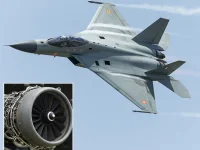- Views: 3K
- Replies: 7
India is poised to significantly expand its fleet of indigenous fighter jets, with Hindustan Aeronautics Limited (HAL) and the Indian Air Force (IAF) preparing to finalize a landmark agreement for an additional 97 LCA Tejas Mk1A aircraft.
Sources indicate that the deal is on track to be signed by the end of 2025, a move bolstered by a commitment from American firm General Electric (GE) to supply the required engines.
A critical component of this expansion is the secured supply of power plants for the aircraft. GE has committed to delivering approximately 24 F404-IN20 engines annually from 2026 onwards.
This steady supply is essential for HAL to maintain its production line and deliver the new jets to the IAF without delay.
The upcoming order for 97 jets will require an estimated 130 engines, a figure that includes spares for maintenance and operational reserves. This follows a previous order for 99 engines placed for an earlier contract of 83 Tejas Mk1A jets signed in 2021, bringing the total Mk1A fleet size to 180 aircraft.
The Tejas Mk1A is an advanced, more lethal variant of the single-engine Light Combat Aircraft (LCA), featuring an Active Electronically Scanned Array (AESA) radar, an advanced electronic warfare suite, and superior combat capabilities.
The GE F404 engine is recognized for its reliability and performance, which is central to the Tejas program. These new aircraft are vital for the IAF's modernization plans, as they are slated to replace the ageing squadrons of MiG-21, MiG-23, and MiG-27 jets.
Discussions are also underway to establish a domestic maintenance, repair, and overhaul (MRO) facility for the F404 engines.
As the initial batch of Tejas Mk1 aircraft, inducted nearly a decade ago, approaches its first major overhaul cycle in the next two to three years, creating local MRO infrastructure has become a priority. The IAF and GE are reportedly in talks to appoint an Indian company for these services.
Establishing a local MRO hub is a strategic objective aligned with the Indian government’s “Atmanirbhar Bharat” initiative.
Such a facility would dramatically reduce the turnaround time for engine repairs, lower long-term maintenance costs, and decrease dependence on foreign support, thereby enhancing the operational readiness and self-sufficiency of India’s national defence sector.




